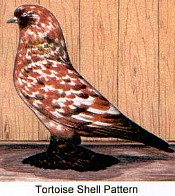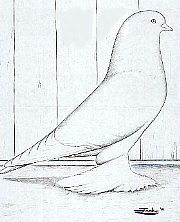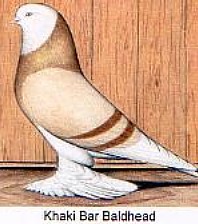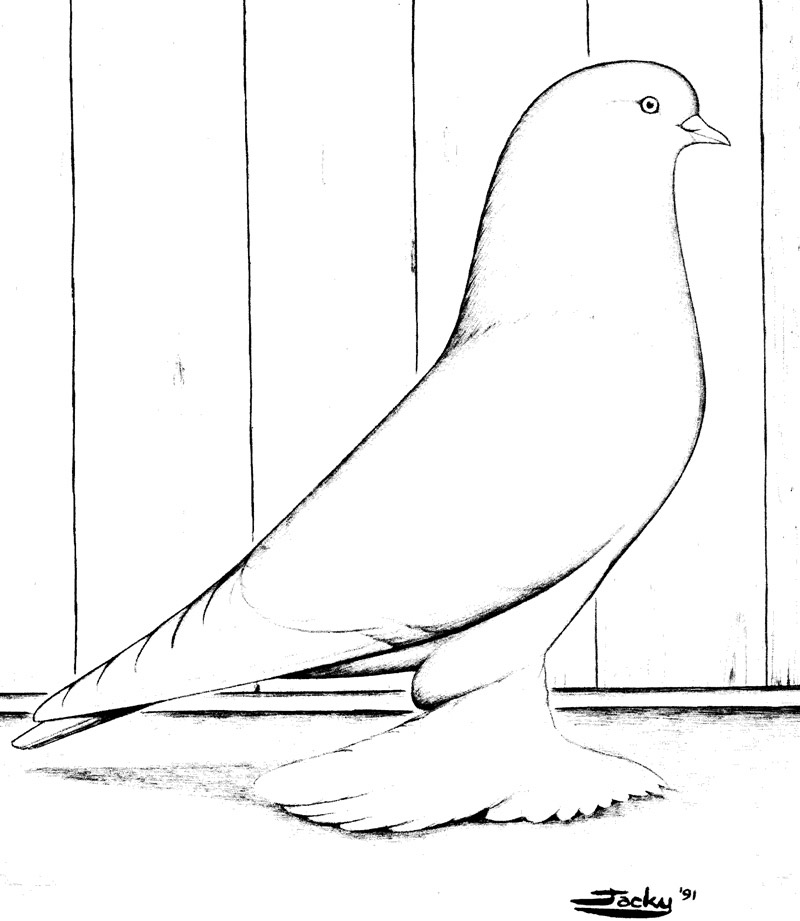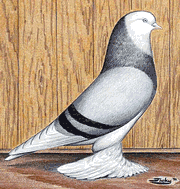

|

As
Adopted by the NWOETC August 15, 1999
Standard Picture. The West of England Tumbler portrayed in the standard picture is a cock bird. Evaluating Hens. Hens are generally slighter in head, frontal, and body characteristics then cocks. This difference is to be taken into consideration and allowed for when evaluating hens to the standard. Evaluating Faults. A fault is any deviation from the ideal West as described in the written standard or as portrayed in the standard picture. All faults not specifically identified as major faults or disqualifications should be evaluated by degree of expression. If a fault is expressed to a small degree or slightly it should be considered a minor fault. If the fault is expressed to such an extreme that it is no longer representative of the breed or color it should be considered a major fault. No birds are to be faulted or awarded for characteristics that are not specifically stated or reasonably implied in the written standard or from the standard picture. BODY (15 Points) -- Wedge shaped, broad shoulders, chest full and well rounded. Body to be medium build and not to appear bulky, stocky or heavy set. Wing butts and wing line to blend well into the chest so as that the wings and chest appear as one. The keel is to be straight, not deformed, and to blend well into the body. While standing at attention cocks should stand approximately 9 inches tall and hens should stand approximately 8 1/2 inches tall. Weight: (Cocks) = approx. 11 - 12 oz. (Hens) = approx. 9 - 10 oz. Major Faults: Protruding wing butts. CARRIAGE (10 Points) -- Upright, erect, bold and jaunty, and alert in appearance. There should be expressed a sense of power (the result of fullness in the head, neck, and chest) but not overly pronounced as to be out of proportion to the body. While standing at attention the body should be at approximately a 45 degree angle to the floor. Tip of tail should be approximately 1/2 inch beyond the wing tip. While standing at attention, tip of tail is to be one quarter to one half inch from the floor and the eyes to be aligned over the front toes. Bird to be well balanced in appearance with all body parts proportionate to each other and flowing smoothly together presenting the impression of refinement, harmony and balance. Major Faults: Refuses to station - continually paces, squats, boats (stands with chest and tail parallel to the floor), or hunkers (stands with head pulled into body). LEGS & MUFFS (4 Points) -- Legs are to be well set, of medium length, and not knocked kneed or bow legged. Muffs should be full and of medium length (approximately 3 to 3 1/2 inches) and in proportion to the body but not too profuse nor form a half circle. Front toes should not be exposed but concealed with short feathering. There should be a definite break between muffs and hocks. HEAD (8 Points) -- Oval and of medium size. The head should taper in an oval shape to back of the neck with a fairly high rounded and moderately broad forehead. The head should show no acute angles, marked flatness but round headed in appearance. The head should exhibit definite backskull which blends imperceptibility into the neck. The backskull should not be overly pronounced as to cause a flat headed appearance. Feathering to have the appearance of forming a smooth, close shell. There should not be excessive feathering around the eyes presenting an eyebrow or browy look nor excessive feathering around the cheek area presenting a puffy or cheeky look. NECK (2 Points) -- Of medium length, full, broad at shoulders. Neck to blend smoothly into chest, shoulders, head and throat with no folds or creases. Neck to be full in feather but to have a smooth contour free from raggedness, frizziness, excessive looseness, swirls, and breaks (open spaces) in the contour. EYES (5 Points) -- Iris pearl to white in color, clear, even in color, free of cloudiness and free from gravel (flecks of color). Iris to fit flush against the eye cere so as no eye muscle is exposed between the iris and the eye cere. Pupil should be round, centered, black and as small as possible. Eyes should not be recessed (sunken in). "Bull or Cracked" eye and yellow, orange, or red colored eyes will constitute an automatic disqualification. EYE CERE (2 Points) -- Small and threadlike of fine texture. Eye cere to be closely feathered with no skin exposed between feathering and eye cere. WATTLE (2 Points) -- Small, close fitting, neat and fine in texture. Wattle should be powdery white in color. BEAK (5 Points) -- Medium in length and thickness, free of coarseness, and smooth with no scaling. When bird is standing at attention beak should have a slight downward look. The line between the lower and upper beak if extended in a straight line should pass through the bottom edge of the eye. HOCKS (2 Points) -- Short in length and not to be profusely feathered. FLIGHTS & TAIL (10 Points) -- Flights tightly folded, broad and short coverts closing neatly over and covering the rump (commonly referred to as back coverage). There should be no razor back flights (flights protruding higher than the shield when the wing is closed). Tail closely folded and slightly wedged allowing flights to rest on the tail with tips of flights to just touch. Tail and primary flight feathers to be strong and medium in width. Tail should be one feather wide. Twelve tail feathers only. Thirteen or more tail feathers constitute an automatic disqualification. Major faults: Flights held below the tail and razor back flights. COLOR (10 Points) -- See Specific Color Descriptions for color descriptions. MARKINGS (10 Points) -- See Specific Color Descriptions for marking descriptions. CONDITION (15 Points) -- All specimens
shall be shown in a natural and healthy condition. Alert, clear
and free of parasites. Feather texture should be medium to
hard and smooth and silky in texture and appearance, not coarse,
loose, ragged, or frizzy. Points shall be deducted for lice,
lice holes, mites, dirt, grit and feeding stains, molting, feather
rot, broken and frayed feathers, feathers not fully grown, deformities
and other areas the judge deems as part of condition.
Summary of disqualifications under the standard:
Summary of major faults under the standard:
GENERAL ALL COLORS - Rich, sound, and lustrous in color
throughout. Even shades, well extended into the roots of the
quills. Full bright plumage with an abundance of sheen.
All birds should have clean and bright color without smut, dirtiness,
or sootiness. There should be no yellowish, orangish, or reddish
beaks or eye ceres. All beak colors, other than flesh colored,
may show a gradation of color from light to dark or dark to light.
Stained, where used in beak color descriptions, refers to splotches,
streaks, or irregular patches of color. Markings Barred to have two
distinct bars medium in width and extending from the lower edge
of the wingshield into the upper edge. There is to be a slight
gap between the bars at the upper edge. Wingshield background
to be free of sootiness and ticking. There should be no white in
the rump, vent, and hock area. There should be no sign of
a third bar.
Color
Bars or checks dark as possible with wingshield background to be
clear even light shade free of smut or dirtiness. Head color
to be rich even shade, neck feather iridescent dark shade, neck
color to match bar or check color as closely as possible.
Color in lower neck and chest to gradually diminish and blend into
lighter shade of the body.
ALMOND (Almond Blue).  Picture
PictureMARKINGS - Flecks of various colors to appear in the feathering over all parts of the bird. Flecks may vary in size and color but should be somewhat evenly distributed. Each feather of the primaries, secondaries, and tail feathers should have three colors in patches. COLOR - Ground color to be a rich golden almond to reddish almond in color. Flecks and patches to be rich shades of bronze and dark/blackish kite. Beak may be light or flesh colored, dark horn, or stained. Eye ceres may be flesh colored, greet, or mixed. (Note: red and yellow agates are recessive reds and dilute recessive reds raised from an almond bred family. When exhibited they are to be shown in the appropriate red and yellow color classes. See Selfs Red and Selfs Yellow for color description.) ANDALUSIAN (Indigo Spread Blue).  Picture
PictureMARKINGS - Wingshield with fine but distinct lacing in each feather. Bird to be free of flecking and splotches. COLOR - Body and tail midnight blue shading to very dark midnight blue, almost black, in the chest, neck and head. The wingshield a bit lighter than body with dark midnight blue lacing. Color to be free from reddish tint or bronzing. Beak dark horn to black with grayish eye ceres or beak and eye ceres flesh colored. BRONZE PATTERNS (modena bronze and other genetic factors (other than indigo) that turn standard bars, checks, T-patterns, and velvets bronze). Bronze bars, bronze checks, bronze dark checks, and bronze shields (velvets) MARKINGS - Descriptions same as standard pattern bar, check, dark check, and velvet markings descriptions except bars, checks, and dark checks to be laced. Lacing to be fine but distinct. Bronze shields (velvets) to have even colored wingshield free of any lacing or sootiness. COLOR - Color descriptions,including beak and eye cere, same as standard pattern bar, check, dark check, and velvet color descriptions except the neck and chest may be darkened and the wingshield pattern is changed to bronze. Bar, check, dark check, and velvet pattern areas to be rich even bronze free of grizzling or whitening. Lacing to be the same color as what would be the normal shield pattern color for that color, i.e. a bronze bar silver would have bronze bars edged with dun lacing. Body, chest, and neck is to be free of bronze splotches and patches but may show a bronzy cast. DEROY (Recessive Red Almond).  Picture PictureMARKINGS - Flecks of dark gold to red to appear in the flights and tail. Flecking may also occur through out head, neck, and rest of body. COLOR - Ground color to be rich dark yellow to gold. Flecks and patches to be rich shades of darker gold to red. Beak may be flesh colored, light to medium horn, or stained. Eye ceres may be flesh colored, grayish, or mixed. GOLDEN DUNS (Dilute Kite Bronze T-Pattern Blue) MARKINGS - Checks not to show through wingshield but may show a tail bar. COLOR - Body, head, and neck dark dun saturated with golden or sulfur bronze. Tail, flights, and muffs dark dun saturated with golden or sulfur bronze extending outward from the quills. Beak light to medium horn and eye ceres grayish. GRIZZLE  Picture PictureMARKINGS - Same as standard pattern markings. COLOR - Color descriptions, including beak and eye cere, same as standard bar, check, dark check, velvet, and barless color descriptions except the head, body, and wingshield background is covered with an even peppery combination of white with the basic color with neither color predominating. The neck to have a frosty appearance. Grizzling is nearly absent in the tail bar and wingshield pattern area. INDIGO (Indigo Blue). MARKINGS - Descriptions same as standard pattern bar, check, dark check, and velvet markings descriptions. COLOR - Wingshield background and body darker than normal. Wingshield pattern (bar, check, dark check, velvet), chest, and neck a rich indigo bronze. Velvets to have rich even indigo colored wingshield. Tail and primaries steel gray. Beak dark horn and eye ceres grayish. KITE (Bronze T-Pattern Blue).  Picture PictureMARKINGS - Checks are not to show through wingshield but may show a tail bar. COLOR - Body, head, and neck dark/blackish saturated with bronze. Tail, flights, and muffs dark saturated with bronze extending outward from the quills. Beak dark horn and eye ceres grayish. OPAL PATTERNS  Picture Picture(dominant opal, toy stencil and other genetic factors that turn standard bars, checks, and T-patterns to a light opal (milky) bronze). Opal bars, opal checks, opal dark checks (light opal (milky) bronze shield with colored lacing). MARKINGS - Descriptions same as standard pattern bar, check, and dark check markings descriptions except bars and checks may or may not be laced. Dark checks to be laced. Lacing to be fine but distinct. COLOR - Color descriptions, including beak and eye cere, same as standard pattern bar, check, and dark check color descriptions except the neck and chest may be lightened and the wingshield pattern is changed to light even opal (milky) bronze. Bar, check, and dark check pattern areas to be a light even opal (milky) bronze free of white. Lacing to be the same color as what would be the normal shield pattern color for that color, i.e. an opal bar silver would have light opal (milky) bronze bars edged with dun lacing. Body, chest, and neck to be free of bronzing. PEARL (Dilute Indigo Spread Blue). MARKINGS - Wingshield with fine but distinct lacing in each feather. Bird to be free of flecking and splotches. COLOR - Body and tail light pearl gray shading to a darker gray in the chest, neck and head. The wingshield a little lighter than body with darker gray lacing. Color to be free from yellowish/reddish tint or bronzing. Beak medium horn to dun with grayish eye ceres or beak and eye ceres flesh colored. REDUCED MARKINGS - When combined with standard patterns bar, check, and dark checks same as standard pattern markings except bars, checks, and dark checks to be edged with fine but distinct darker lacing. In all laced reduced patterns each feather in wingshield to be edged with a darker (darker than wingshield) fine but distinct lacing. Head may have darkish masklike cast. COLOR - Reduced can be combined with any color. It has the effect of lightening or reducing basic colors to light pastel shades while reducing the wingshield pattern to even lighter pastel shades. Bars and checks should be light even pastel color free of bronzing. Tip of beak may show darker spot except for reduced recessive yellow, gold, and red. Gray Bar (Reduced Spread Blue Bar). Tail, legs, muffs, head, and body dark gray shading to an iridescent light silvery gray neck. Bars very light pale gray, almost white, and even in color. All color including bars to be free of bronzing. Beak medium horn and eye ceres grayish.
WHITE PATTERNS (dominant opal, toy stencil and other genetic factors that turn standard bars, checks, and T-patterns to white).
YELLOW TICK (Dilute Spread
Ash-Red Check or T-Pattern). SELFS MOTTLES Shield Mottle:
Mottle: Bird more
than 50% colored with whole white feathers interspersed fairly evenly
throughout the entire body. Bird should be at least 20% white
through out the head, neck, body, and wingshield. Primaries, muffs,
and tail may be colored, colored interspersed fairly evenly with
white feathers, or white interspersed fairly evenly with colored
feathers, but should not be solid white. Quantity of white
feathers should be about the same on both sides. Rosewing: 6 to 12 white feathers upon each shoulder arranged at equal distance within a circular form, both sides alike. All else solid colored. Whiteside: Wingshield, including finger feathers, to be white. Secondaries may be all white or all colored. Primaries and all else to be colored. Major faults: white in tail or primaries. COLOR - See appropriate self or pattern color description. Stained beak is allowable in all colors other than red, gold, and yellow. Stained beaks in reds, golds, and yellows will constitute a loss of points. BALDHEADSMARKINGS - Head, rump, tail, underside of body, thighs, hocks, muffs, and primaries to be white. Neck, chest, upper body, and wingshields, including secondaries to be colored. Color to extend into the body ending in a clean line approximately one inch forward of the legs. Head marking to form a V shaped bib with the point approximately one half inch below where the beak would touch the neck if the head were bent down. The white should end on the back of the head at a point where a line drawn from the gap at the base of the beak where the upper and lower beaks meet through the bottom edge of the eye would meet the back of the neck. No white to show where wing butts blend into the body. Beak and eye ceres to be flesh colored. Colored hocks or thighs, colored primaries or white secondaries, and a bruised or stained beak will constitute a loss of points. For pattern markings see appropriate pattern marking description. Major faults: If any of the outside eight primary flights are colored; if any secondary other than the two outside secondaries are white; to have a colored feather or feathers between any white flight feathers; or solid colored thighs and hocks. COLOR - For color description see appropriate pattern or self color description. (Note: red and yellow baldheads to have solid even colored neck, chest, body, and wingshield free of lacing. They may exhibit ash ticking in the secondaries.) MARKED
|

